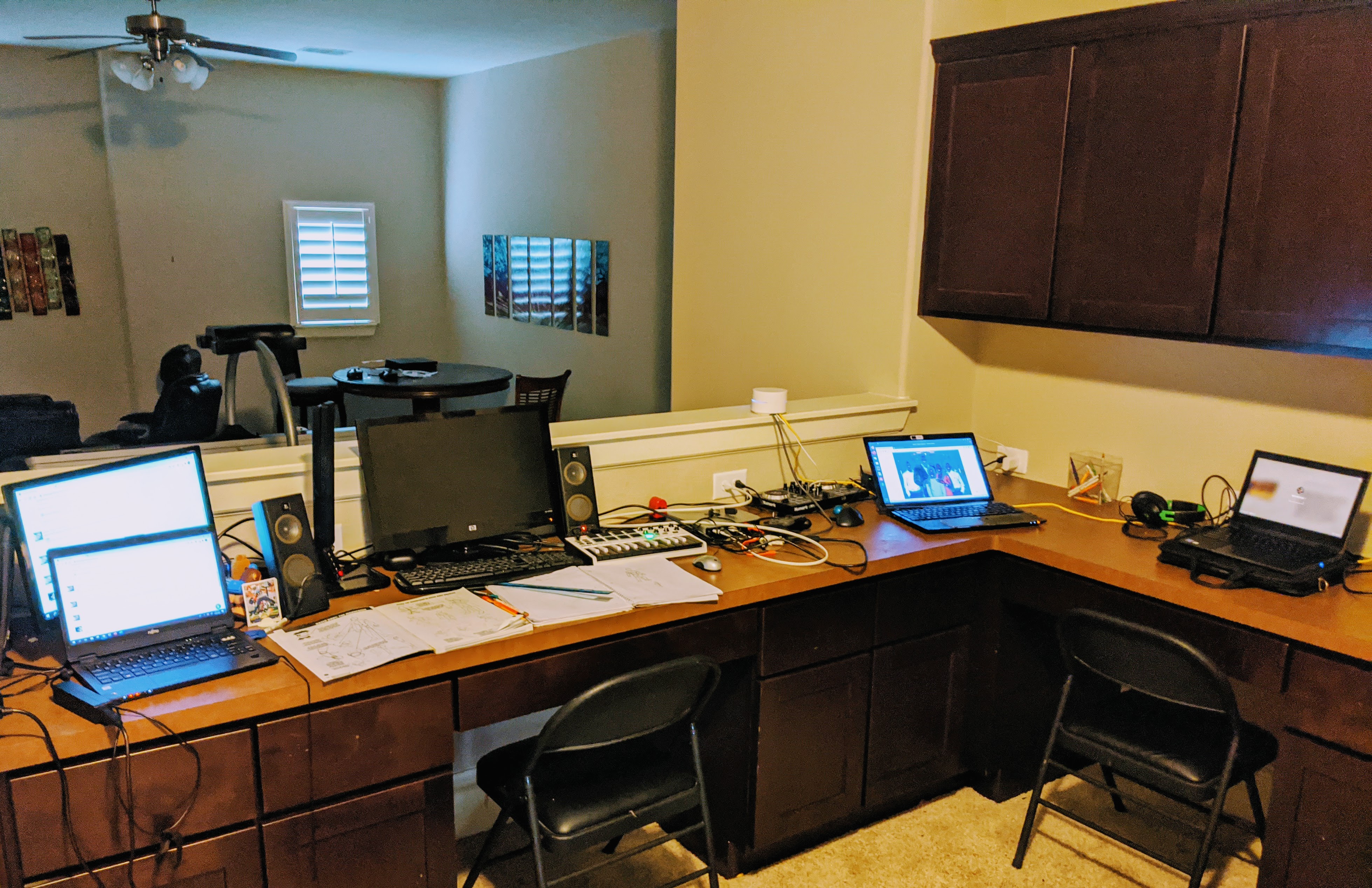Prepare Your Teens to Learn Online
My wife and I have three teen-agers, and they will start a new experience in a few weeks. For the first time ever, they will start a school year while staying at home. Instead of our usual ritual of getting them dressed and out the door for the first day of class, they will meet their new teachers and classmates through an online video conference.
I’m an Engineering Coach at Help Scout which is a company that was created from the beginning to be a remote organization. I’ve also worked remotely at other companies so I have a lot of experience thriving in environments where I have to be successful without being in person. I’ve written a post about my remote work office setup which details the gear I use to work from home.
We approached setting our kids up to successfully learn online based on what I’ve learned as a remote worker. This post lays out the setup we created to help our kids thrive while virtually learning.
Environment
The learning environment you create for your kids is a critical part of their ability to navigate this new version of school. You want to maximize their virtual experience while removing any distractions that will make it hard for them to focus.
We’re fortunate to live in a house that has an area called a “learning center” upstairs. When ours kids went to school, this part of the house wasn’t used very much. Now that they will start learning online every day,we’ve transformed it into a key part of their education experience.
Internet
Our house is filled with security cameras that constantly stream video footage to the internet, and there are a variety of other online devices. I’m on video calls in my office for most of the working day, and my wife also needs the ability to teach her classes online. So, making sure our kids have enough bandwidth for several hours of instruction delivered over the web presented an interesting challenge.
Fortunately, we live in an area with access to high speed internet delivered over fiber. We tested getting everyone in my family online on a video call while also streaming several ultra high quality movies. Our connection handled that load without any problems.
We recommend doing a similar test and seeing how your internet service performs. You may need to upgrade to a higher tier of service.
Desk
You should provide a desk for your kids to use while they learn online. They may want to sit on a couch or sofa (or even lay in bed), but you need to insist that they use a desk. This will replicate the way they learned when they were in school, and it will communicate to their teachers that they are taking their education seriously.
Chair
Your teens will spend several hours sitting while they learn so they should have comfortable chairs. Don’t use the card table chairs shown in the picture above. We have proper seating on order from Amazon, and they will be in place well before school starts.
You don’t have to provide your kids with the expensive office chairs you see in a lot of workplaces. However, you should definitely invest in something you wouldn’t mind sitting in for five or six hours a day.
Lighting
We can’t stress enough how important lighting is when kids are in a remote learning environment. First, the people on the other side of the video call will be able to clearly see your kids. Second, your kids will be less likely to suffer from eye strain.
We went further and ordered some light therapy lamps (also called “Seasonal Affective Disorder [SAD] lights”) that provide light and also mimic sunlight to facilitate energy and focus. The learning center area in my house doesn’t have windows near it so we wanted to provide a way for my teens to get something close to sunlight while they learn.
Invest in Quality Equipment
You’ll want to get the best possible equipment for your teens. That includes the computer, keyboard, mouse, monitor, and microphone they’ll use ever school day. We also recommend getting a secondary monitor for each student since that provides one monitor for video calls and another monitor for doing work.
It’s easy to spend a lot of money buying equipment for your teens to use at home. However, compared to even a decade ago, computing power is relatively cheap. You may even have old computer equipment around your house that you can re-purpose and use. You can also buy what your budget allows for now and then upgrade later.
Minimize Distractions
When school starts for my teens, we’ll collect their phones and the power cords of the gaming consoles the night before every school day. That guarantees that ours teens won’t be tempted to play on their phones or get in a few rounds on a video game when they’re supposed to be learning.
We even recommend keeping video game consoles and other distractions out of the room where your teens will be learning. That will reduce the risk of them even thinking about how to finish that new version of Fortnite when they should be listening to their teacher.
Communication
Your teens will need to over-communicate with their teachers and peers. When you don’t occupy the same physical space with someone, then you don’t get the non-verbal communication visuals that humans subconsciously use to process tone and intent.
Your teens should send a weekly check-in email to their teachers. They will resist doing this, but you should insist that they do it. This is just a quick email summarizing what your teens have learned that week and make sure that haven’t missed anything.
Social
There are all kinds of social cues that are missed when you’re remote from other people. Your teens will need to take specific actions to fill in the void created by distance.
Hygiene
Your teens may wonder what’s the point, but they need to shower, put on deorderant, brush their teeth, comb their hair, and tend to the same rules of hygiene they followed when they went to school. First, this helps them mentally prepare for learning. Second, their siblings will appreciate it. If you have an only child, then you’ll appreciate it when you walk past the learning area you’ve set up in your home.
Dress
Have your teens get dressed for learning from home like they would if they were going to school. They can follow the “business on top, party downstairs” method of wearing a school-appropriate shirt while having shorts or baggy sweats on beneath the view of the camera. But, they need to look presentable.
Camera On
Your teens need to have their camera on when they are in a virtual learning session. This keeps them engaged and also silently communicates to the teacher that they are interested in the lesson material.
Take Notes
Encourage your kids to have pen and paper next to their computers and take notes! Again, your teachers will see the students who are writing things down. Your teens need to understand how important it is to show teachers that they find what’s being said important enough to write down.
Schedule
Time management is a critical life skill, and learning from home is a great opportunity for your teens to get better at it!
Ease into the Day
Don’t let your kids roll out of bed and immediately login to their first virtual class. It’s important that they have some ritual before they start their school day. This could be as simple as eating breakfast or, if safe to do so, taking a walk around the block.
Class Hours
Your teens need to understand that class hours are times for extreme focus. They should have their schedules clearly printed out and displayed in the area where they learn. If they have phones, they should add their class schedule to a calendar app.
Lunch
It’s important to eat lunch! We also recommend having your kids leave the learning area to consume their meals. This gives them a mental break and reduces the chance that they’ll come to see living at home as just an endless day at school. We plan to let them have their phones back during lunch so that they can socialize with their friends. However, we take their phones back when lunch time is over.
Take Breaks
Work with your teens to find other break times during the day. These are little ten or twenty minute opportunities to get a snack, take a walk, etc. The key is to get up and move.
Form Study Groups
Your teens need to get in study groups. This is a great practice that will help them get ready for college level learning. They need to master learning with others even when it’s done online.
After Action Review
Check-in with your teens at the end of each day. They should let you know the highlights of what happened and also share any issues they need your help to resolve. We make the daily check-in a requirement for getting their phones and game console power cords back. This incentivizes them to come to us for the check-in (instead of trying to hunt them down).
Manage Expectations
No matter what you do to prepare your teens for online learning, it’s important for you to admit that this is new. There will be imperfections in their learning environment and in how their school executes online learning.
Keep things as simple as you can. Set clear guidelines but don’t micro-manage your teens. Let them know that you expect to find ways to constantly improve their learn-from-home experience. Talk to your teens regularly, get their feedback, and make changes based on what they share with you.


